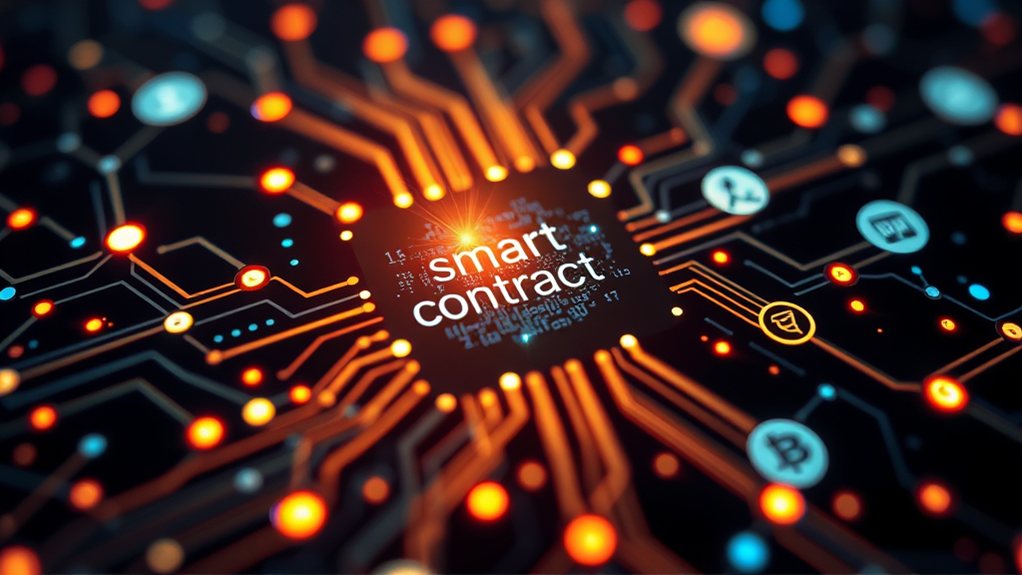Decentralized Applications (DApps) are apps that run on blockchain networks instead of central servers. They use smart contracts to execute transactions automatically without middlemen. Unlike traditional apps, DApps store data across multiple computers, making them harder to hack. They're built on platforms like Ethereum and EOS, serving various purposes from finance to gaming. DApps offer users more control over their data and digital assets, though they face challenges in scalability and user experience. More benefits and uses await exploration.

While traditional apps rely on centralized servers controlled by single companies, decentralized applications (DApps) are changing how software works across the internet. These software applications run on decentralized networks instead of a single computer. They use blockchain technology or peer-to-peer networks to operate without any central authority. What makes DApps unique is their open-source code that anyone can view and verify.
DApps consist of several key technical components. Smart contracts form their backbone, allowing for automatic execution of agreements without middlemen. They store data on distributed ledgers where information is spread across many computers rather than a single database. Users interact with DApps through front-end interfaces that look similar to regular apps, but the back-end code runs on a decentralized network. To reach agreement on transactions, DApps use consensus mechanisms where network participants validate information.
Several platforms host these applications today. Ethereum remains the most popular for DApp development, with thousands of applications built on its network. Other notable platforms include EOS, which focuses on speed; TRON, which targets entertainment applications; Cardano, which emphasizes research-driven development; and Polkadot, which enables different blockchains to work together.
Ethereum leads the DApp ecosystem, while platforms like EOS, TRON, Cardano, and Polkadot offer specialized blockchain environments for developers.
The uses for DApps span many industries. They're most visible in decentralized finance (DeFi), where they enable lending, borrowing, and trading without banks. NFT marketplaces use DApps to buy and sell digital collectibles. Games like Axie Infinity use DApp technology to give players ownership of in-game assets. Some DApps focus on social media without censorship, while others track products in supply chains. DApps also enable decentralized governance through DAOs where members can vote on proposals and make collective decisions. Users can also participate in yield farming activities to earn passive income from their cryptocurrency holdings.
DApps offer several advantages over traditional applications. They're harder to hack because there's no single point of failure. All transactions are visible on the blockchain, creating transparency. Users often pay lower fees because there are fewer middlemen. People maintain control of their own data and digital assets. And since no single entity controls the network, DApps resist censorship and typically don't experience downtime.
However, DApps face significant challenges. Many struggle with scalability, becoming slow when too many people use them at once. The user experience often feels clunky compared to polished traditional apps. Regulations around DApps remain unclear in many countries. Smart contracts can contain bugs that lead to security problems. And many potential users find the technology too complex to adopt. Despite thousands of DApps being available, only a small percentage account for most user engagement, with approximately 80% of DApps on Ethereum having fewer than 1000 users.
Looking ahead, DApps are likely to evolve with improvements in several areas. They're beginning to incorporate artificial intelligence and connect with Internet of Things devices. New solutions are addressing speed limitations. Different blockchain networks are becoming interoperable. Privacy features are improving. And more businesses are exploring DApps for everyday applications.
Frequently Asked Questions
How Do DAPPS Make Money if They're Decentralized?
DApps make money through several methods despite being decentralized. They collect transaction fees when users perform actions on the platform.
Many sell tokens through initial coin offerings or ongoing sales. Some display ads or sponsored content to users.
Premium features and subscription services provide another revenue stream. The decentralized nature doesn't prevent profit-making; it simply changes how funds flow through the system.
Can DAPPS Be Shut Down by Governments?
Governments face major challenges when trying to shut down DApps.
While they can't easily stop the core blockchain technology, they do have some options. They might block websites that connect to DApps, restrict banking services, or take legal action against developers.
However, DApps continue running on distributed networks with no central point of failure, making complete shutdown nearly impossible in most cases.
What Programming Languages Are Best for Developing DAPPS?
For dApp development, several programming languages serve different purposes.
Solidity dominates smart contract development on Ethereum, while Rust powers Solana projects.
JavaScript and TypeScript are essential for frontend interfaces, often using Web3.js libraries.
Python offers versatility across both frontend and backend systems.
Emerging languages like Move and Clarity serve specialized blockchain platforms.
The best choice depends on the target blockchain and specific application requirements.
How Do DAPPS Handle User Authentication Without Central Servers?
DApps authenticate users without central servers through blockchain-based solutions.
They often use wallet-based authentication, where users sign in with their cryptocurrency wallets using cryptographic keys.
Decentralized identity systems let users control their digital identities across applications.
Smart contracts handle access rules automatically.
Multi-factor authentication adds security layers through biometrics or hardware tokens.
This approach prevents single points of failure and gives users more privacy control.
Are There Any Successful DAPPS With Millions of Users?
Yes, several DApps have achieved millions of users.
Uniswap leads DeFi platforms with 3.9 million monthly active users, while PancakeSwap has 2.8 million.
In gaming, Axie Infinity reached over 2.7 million daily users at its peak.
OpenSea dominates NFT marketplaces with 2.3 million active users.
Social platform Minds has registered over 5 million users.
These numbers show DApps can reach mainstream adoption across various sectors.










